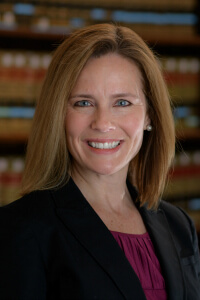

|
Potential Supreme Court nominee profile: Amy Coney Barrett
 A potential pick for the next appointment of Associate Supreme Court Justice, Amy Coney Barrett. The Dems will go apoplectic will this nomination. Ginsburg is 85 now and can barely complete a full sentence without pausing. A potential pick for the next appointment of Associate Supreme Court Justice, Amy Coney Barrett. The Dems will go apoplectic will this nomination. Ginsburg is 85 now and can barely complete a full sentence without pausing.[SCOTUSblog] In November 2017, President Donald Trump released a revised list of potential Supreme Court nominees. The November 2017 list was an expanded version of two earlier lists, announced during the 2016 presidential campaign, from which then-candidate Trump pledged, if elected, to pick a successor to the late Justice Antonin Scalia, who died on February 13, 2016. First on the new list ‐ because it was in alphabetical order ‐ was Amy Coney Barrett, a Notre Dame law professor (and former Scalia clerk) who had recently been confirmed to a seat on the U.S. Court of Appeals for the 7th Circuit. Barrett’s confirmation hearings had received considerable attention after Democrats on the Senate Judiciary Committee ‐ most notably, Senator Dianne Feinstein of California ‐ grilled her on the role of her Catholic faith in judging. Feinstein’s criticism did not stop Barrett from being confirmed, and since then there has been speculation that it may have in fact strengthened her case to fill the seat that will be vacated by the retirement of Justice Anthony Kennedy. The 46-year-old Barrett grew up in Metairie, Louisiana, a suburb of New Orleans, and attended St. Mary’s Dominican High School, a Catholic girls’ school in New Orleans. Barrett graduated magna cum laude from Rhodes College, a liberal arts college in Tennessee affiliated with the Presbyterian Church, in 1994. (Other high-profile alumni of the school include Abe Fortas, who served as a justice on the Supreme Court from 1965 to 1969 and Claudia Kennedy, the first woman to become a three-star general in the U.S. Army.) At Rhodes, she was a member of Phi Beta Kappa and was also recognized as the most outstanding English major and for having the best senior thesis. After graduating from Rhodes, Barrett went to law school at Notre Dame on a full-tuition scholarship. She excelled there as well: She graduated summa cum laude in 1997, received awards for having the best exams in 10 of her courses and served as executive editor of the school’s law review. Barrett then held two high-profile conservative clerkships, first with Judge Laurence Silberman of the U.S. Court of Appeals for the D.C. Circuit, from 1997-1998 then with the late Justice Antonin Scalia, from 1998-1999. After leaving her Supreme Court clerkship, she spent a year practicing law at Miller, Cassidy, Larroca & Lewin, a prestigious Washington D.C. litigation boutique that also claims former U.S. solicitor general Seth Waxman, former deputy attorney general Jamie Gorelick, and two regular contributors to this blog ‐ John Elwood and editor Edith Roberts ‐ as alums. Barrett went to Baker Botts, a Texas-based firm, after Miller Cassidy merged with the larger law firm, in 2000 and spent another year there before leaving for academia. To the chagrin of Democratic senators during her confirmation process, Barrett was only able to recall a few of the cases on which she had worked, and she indicated that she had not argued any appeals while in private practice. Posted by: Besoeker 2018-10-09 |
| http://www.rantburg.com/poparticle.php?ID=525040 |